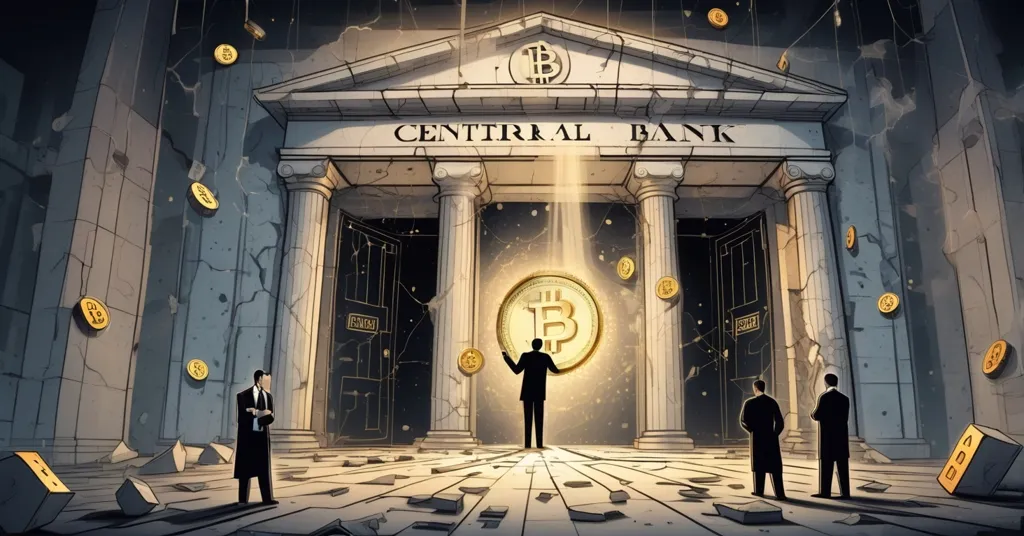Fed Lawsuit Exposes Secrecy, Boosts Bitcoin’s Case Against Centralization

New Lawsuit Slams Federal Reserve Secrecy, Fuels Crypto’s Case Against Centralization
Jerome Powell, Chair of the Federal Reserve, is facing a fiery legal challenge as Azoria Capital, led by CEO James Fishback, sues to force open the secretive doors of Federal Open Market Committee (FOMC) meetings. Filed in a Washington, D.C. federal court, this lawsuit targeting FOMC transparency—paired with Donald Trump’s relentless criticism and a rare visit to Fed headquarters—exposes the glaring flaws of centralized financial systems, handing Bitcoin and decentralized finance (DeFi) a perfect case study in why trustless, transparent alternatives are the future.
- Legal Firestorm: Azoria Capital sues Powell and FOMC for violating a 1976 transparency law, demanding public access to the July 29-30 interest rate meeting.
- Political Clash: Allegations of high rates sabotaging Trump’s agenda mix with a controversial $2.5 billion Fed renovation, spotlighted by Trump’s unprecedented visit.
- Crypto’s Win: Centralized opacity and political meddling amplify the appeal of Bitcoin and DeFi as independent, open systems.
Azoria Capital’s Battle for Transparency
The lawsuit, lodged in the U.S. District Court for the District of Columbia, accuses the FOMC of flouting the Government in the Sunshine Act of 1976 by holding monetary policy discussions in secret. For the uninitiated, the FOMC is the Federal Reserve’s key decision-making body, setting interest rates that can make or break economies overnight—think deciding whether borrowing gets pricier (slowing growth but taming inflation) or cheaper (boosting spending but risking price spirals). Azoria demands a temporary restraining order to make the upcoming July 29-30 meeting public, arguing that closed-door deliberations leave firms vulnerable to sudden policy shifts they can’t predict or protect against. In plain terms, if a rate hike blindsides you, your investments could tank before you even know what hit you. For more on the legal details, check out this in-depth analysis of Azoria’s case against the Fed.
“By operating beyond public scrutiny, the FOMC is deliberately undermining the public accountability envisioned by Congress,”
Azoria stated, hammering the point that secrecy isn’t just bad governance—it’s a direct hit to fairness in finance. They doubled down, adding:
“If a firm such as Azoria does not have real-time access to FOMC deliberations, it cannot fully consider and protect itself against Federal Reserve policy shifts that can create volatility.”
This isn’t abstract whining. Market volatility from unexpected Fed moves can wipe out billions in value, and without insight into those discussions, firms are essentially gambling blind. But Azoria’s grievance isn’t just about dollars and cents—it’s dripping with political venom. They allege Powell is deliberately keeping interest rates high to sabotage President Trump’s economic agenda, a charge that echoes Trump’s own accusations of bias. It’s a bold claim, and whether it holds water or not, it’s gasoline on an already blazing feud between the White House and the Fed.
Trump vs. Powell: A Political Powder Keg
Trump has been vocal about his disdain for Powell, claiming the Fed should slash rates by a whopping three percentage points to juice economic growth. Since his return to office, the FOMC has refused to budge, citing the need to gauge how Trump’s trade policies—like hefty tariffs—might stoke inflation. Market watchers, including prediction platform Polymarket, expect no change at the July meeting but foresee a cut by December. Still, with only two Fed governors reportedly favoring a reduction now, the standoff persists. Trump’s frustration isn’t just hot air—he’s taking action in a way rarely seen from a sitting president. For a deeper look at these claims of political bias in Powell’s rate policies, the tension is palpable.
In a move as eyebrow-raising as a Bitcoin whale dumping their entire stack on a quiet Sunday, Trump is set to visit the Federal Reserve headquarters on the National Mall. Flanked by allies like White House deputy chief of staff James Blair, budget director Russell Vought, and Federal Housing Finance Agency Director Bill Pulte (a known Powell critic), the visit is ostensibly to scrutinize a $2.5 billion renovation of the Fed’s Eccles Building. Historically, presidential drop-ins at the Fed are unicorns—think FDR in 1937 or Bush in 2006 for ceremonial moments. This, though? It’s a clear signal of pressure, a not-so-subtle nudge at an institution meant to be insulated from political whims. Learn more about Trump’s controversial visit to the Fed headquarters and its implications. Legally, Powell can’t be fired without cause—think fraud, not policy spats—per a Supreme Court ruling, yet Trump has toyed with the idea, once hinting Powell could be out in eight months (well before his May 2026 term end) before backtracking after a “productive” meeting. The mixed signals, alongside Senate Republicans like Cynthia Lummis backing Trump’s scrutiny and others calling for Powell’s resignation, suggest a dangerous erosion of Fed independence.
Fed’s Financial Fumbles: A Symbol of Centralized Waste
The renovation itself is a lightning rod. Pegged at $2.5 billion (though Trump claims $3.1 billion, a figure Powell disputes as including a separate completed project), the project—started in 2022 with a 2027 target—has ballooned due to toxic material cleanup, pandemic-driven labor costs, and even blast-resistant windows. Critics see it as emblematic of Fed extravagance, especially as the central bank posts operating losses of $114.6 billion in 2023 and $77.5 billion in 2024 from managing high rates to curb inflation. Treasury Secretary Scott Bessent has called for a review of non-monetary operations over these costs, even while labeling Powell a “dedicated public servant.” Meanwhile, market reaction to Trump’s visit was muted—10-year Treasury yields (a benchmark for government borrowing costs) ticked up slightly, and Wall Street stayed mixed, suggesting this drama might be more political theater than immediate economic quake. Still, when the Fed’s burning cash on windows while reporting losses, it’s hard not to smirk and think: Bitcoin doesn’t need a fancy building to run—its code just works. For background on Federal Reserve transparency laws, the context of this criticism becomes clearer.
Crypto’s Counterpunch: Transparency Over Secret Handshakes
This entire mess—secret meetings, political arm-twisting, and billion-dollar renovations amid financial red ink—lays bare why centralized systems like the Federal Reserve are ripe for disruption. Bitcoin, born from the ashes of the 2008 financial crisis when trust in banks cratered, offers a radical alternative: a public ledger where every transaction is visible, verifiable, and untouchable by any single chair or president. For those new to the space, here’s the gist—Bitcoin runs on a blockchain, a decentralized record of transactions maintained by thousands of computers (nodes) worldwide. No one can hide or fudge the data; it’s all out there, unlike the FOMC’s backroom deals. When Azoria can’t predict Fed moves because of opacity, or when Trump leans on Powell for policy favors, Bitcoin just shrugs—it’s immune to such nonsense. Explore how Bitcoin challenges central banking systems as a decentralized alternative.
But let’s not stop at Bitcoin. Decentralized finance, or DeFi, built largely on Ethereum, takes this further with programmable money. Platforms like MakerDAO let users create loans or stablecoins without a bank, using smart contracts—self-executing code that enforces terms without a middleman. Compare that to the Fed setting rates in secret to maybe spite a political foe. It’s night and day. Even niche altcoins play a role; privacy-focused coins like Monero tackle surveillance risks if centralized policies tighten, filling gaps Bitcoin doesn’t aim to cover. For a comparison of DeFi versus centralized banking, the contrast is striking. As a Bitcoin maximalist at heart, I’ll argue BTC’s simplicity and ironclad security make it the ultimate counter to Fed flaws—its fixed supply of 21 million coins is a hard no to inflationary mismanagement. Yet, I can’t ignore Ethereum’s innovation in financial tools or smaller chains pushing boundaries. This ecosystem thrives on diversity, and while Bitcoin is king, the revolution needs all hands on deck.
History backs this up. During past central bank crises—think 2008’s bailouts or 2020’s money-printing spree via quantitative easing—Bitcoin’s price often surged as a safe haven from fiat chaos. If Fed independence keeps eroding, or if losses and opacity persist, expect more investors to eye crypto as a hedge. Heck, even the Fed’s push for central bank digital currencies (CBDCs) smells like a desperate counter to crypto’s rise—digitized dollars under their control, not yours. It’s a stark contrast to Bitcoin’s ethos of user sovereignty, and it’s why this Fed drama isn’t just a sideshow; it’s a megaphone for decentralization’s promise. For community perspectives on this, see this Reddit discussion on Azoria’s lawsuit.
The Flip Side: Transparency and Interference Aren’t Simple Fixes
Before we pop the champagne for crypto’s inevitable takeover, let’s play devil’s advocate. Azoria winning public access to FOMC meetings sounds like a transparency win, but it could be a double-edged sword. Real-time insight into raw deliberations—before final decisions—might spark knee-jerk market reactions. Think traders dumping assets the second a Fed governor hints at a hike, even if it’s just a passing thought. Historically, even Fed leaks or vague statements have triggered volatility; unfiltered access could amplify that chaos. It’s not the neat solution Azoria paints it to be. For insights into why Federal Reserve secrecy faces criticism, the debate is far from settled.
Trump’s meddling carries risks too. If he bends Fed policy for short-term wins, like rate cuts to pump markets, cheap money could flow into risk assets—including crypto—driving prices up temporarily. But long-term, undermining Fed autonomy risks inflation spirals or economic instability, the exact kind of mess that birthed Bitcoin. And crypto itself isn’t immune to fallout. If decentralized systems gain traction amid Fed stumbles, expect regulatory claws to tighten—governments don’t relinquish financial control easily. Plus, Bitcoin’s own volatility and scaling hiccups mean it’s not a perfect lifeboat yet. We’re champions of effective accelerationism, pushing for rapid adoption, but we can’t ignore the rocky road ahead.
Key Takeaways and Questions for Reflection
- Why is Azoria Capital targeting the Federal Reserve?
They accuse the FOMC of violating a 1976 transparency law with closed-door meetings, claiming this secrecy creates financial volatility for firms unable to anticipate policy shifts, and demand public access starting July 29-30. - What’s the political undercurrent in this Fed dispute?
Azoria and Trump allege Powell maintains high interest rates to derail Trump’s economic plans, a tension heightened by Trump’s rare Fed headquarters visit and public criticism. - How does this chaos bolster cryptocurrency’s appeal?
It highlights centralized systems’ opacity and susceptibility to political interference, making Bitcoin’s transparent blockchain and DeFi’s user-controlled platforms compelling alternatives. - Could public FOMC meetings create new problems?
Yes, while transparency might aid planning, live access to unpolished discussions risks immediate market overreactions, potentially worsening volatility before decisions finalize. - Does Trump’s interference help or hurt crypto’s long-term case?
Short-term, policy shifts like rate cuts could boost risk assets like crypto; long-term, eroding Fed stability might fuel economic uncertainty, strengthening crypto’s safe-haven narrative amid chaos. - Are centralized failures enough to accelerate crypto adoption?
They’re a powerful catalyst, driving distrust in systems like the Fed, but crypto’s own challenges—volatility, regulation, scalability—mean adoption hinges on tech improvements and public education too.
The Federal Reserve’s current predicament—under legal siege from Azoria, political heat from Trump, and public scrutiny over wasted billions—paints a damning picture of centralized finance. Powell’s woes are crypto’s exhibit A: when power sits behind closed doors or bends to political whims, trust frays. Bitcoin doesn’t have a chair to oust or a marble HQ to over-budget—it just runs, open for all to see. DeFi and altcoins add layers to this rebellion, crafting tools the Fed can’t match. Sure, the path isn’t flawless; transparency can backfire, and interference might spark short-term wins but long-term pain. Yet, as the Fed stumbles under its own weight, one question looms: will these cracks be the stepping stone for a decentralized future, or just another chapter of centralized dysfunction before real change sticks?



